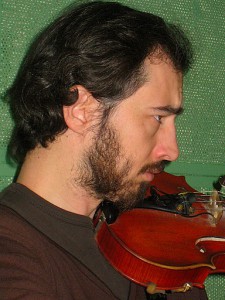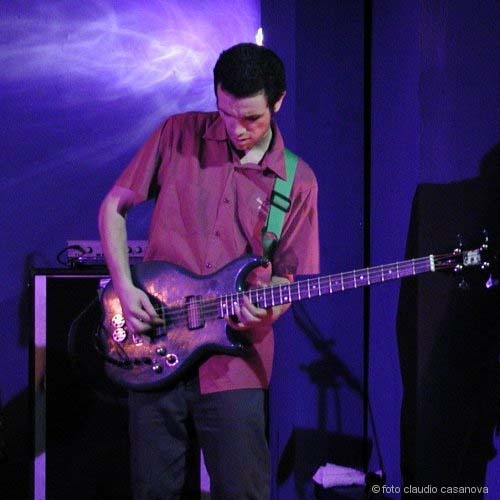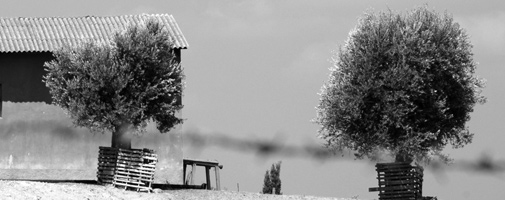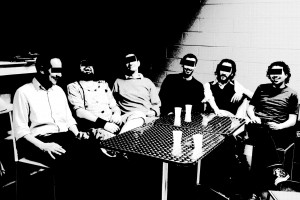MUSICISTA PROFESSIONISTA DAL 1994.
- fondatore nel 1994 del gruppo rock KARMA con cui realizza come compositore, arrangiatore e bassista due dischi in studio (“Karma” e “Astronotus”) e 200 concerti live in Italia.
- dal 1995 al 2005: collaborazione con Fausto Rossi (Faust’o).
- dal 1997 al dicembre 2005 bassista del gruppo rock AFTERHOURS: 3 dischi in studio (” Non è per sempre “, ” Quello che non c’è” , ” Ballate per piccole iene ” ) e il live doppio ( “ Siam tre piccoli porcellin “), oltre 500 concerti e numerose esperienze di cover, tv live, showcases etc. legate all’attività del gruppo.
- nel 1997 supporto al concerto del gruppo irlandese U2, a Reggio Emilia.
- nel 1999 supporto al concerto del gruppo americano REM, a Bologna.
- nel 2002 sonorizzazione della mostra Le Città Invisibili dall’ omonimo romanzo di Italo Calvino alla Triennale di Milano.
- nel 2003 supporto ai gruppi Muse e Red Hot Chili Peppers all’Heineken Jammin’ Festival di Imola.
- nel 2003 registrazioni del personale progetto Ensemble Rough : vari artisti in diverse sessioni per un lavoro di musica improvvisata. Alcune di queste composizioni verranno scelte per la colonna sonora del documentario Porrajmos.
- nel 2003 basso e percussioni per il disco D – Vega (Produzioni Mescal)
- nel 2004 al Midem di Cannes con gli Afterhours: International Music Market.
- nel 2004 attore nel film di Guido Chiesa Lavorare con lentezza e musicista come Afterhours del brano cover degli Area (“ Gioia e rivoluzione ”) motivo base della colonna sonora.
- nel 2004 musicista con strumento indiano sitar per il disco del gruppo Breakfast ( Produzione Mescal) “Ordinary Heroes”.
- dal 2004 bassista del cantautore Luca Gemma (ex leader del gruppo milanese Rosso Maltese): registrazione di 1 disco ( ” Saluti da Venus ” ) e tour live 2004-2005.
- nel 2005 bassista per 3 brani del disco Atleticodefina, degli Atleticodefina .
- nel 2005 bassista del disco in lingua inglese degli Afterhours Ballads for little hyenas ”, distribuito in Europa e Usa.
- 2005 bassista nel disco “Discontinuo blu” di Luca e Davide Miotti (Sony).
- nel 2006 bassista del gruppo rock Muldoon & the other , progetto dell’artista Irlandese David Muldoon.
- nel 2006 fondatore del progetto Juan Mordecai insieme al musicista David Moretti.
- nel 2006 bassista del cantautore Giancarlo Onorato .
- nel 2007 bassista e musicista con strumento indiano sitar nell’ultimo disco del cantautore Luca Gemma “Tecniche di illuminazione” uscito per Ponderosa music & art .
- nel 2007 coproduttore, autore, compositore ,arrangiatore, polistrumentista e tecnico del suono del disco “Songs of flesh and blood “ del progetto Juan Mordecai per V2 music (Universal).
- nel 2007 tecnico del suono sul set cinematografico per lo spot pubblicitario “Autan”.
- nel 2007 approfondimento nel campo della fisica del suono come consulente presso la ditta Cucchi, realizzando trattamenti acustici in numerosi studi di registrazione professionali.
- nel 2008 bassista nel disco dell’artista americana Carla Bozulich “Dandelions on fire “ uscito per l’etichetta Long Song Record.
- nel 2008 bassista per la cantante-attrice Benedetta Laurà , nel quartetto formato da Giampietro Marazza (fisarmonica), Alberto Leone (pianoforte) e Fabio Amodio (batteria).
Professional musician since 1994.
- founder in 1994 of the rock group Karma, with whom he realizes, as a composer, arranger and bassist, two studio album (“Karma” and “Astronotus”) and 200 live concerts in Italy.
- 1995 to 2005: collaboration with Fausto Rossi (Faust’o).
- from 1997 to December 2005, bassist of the rock band Afterhours: three studio album (“It’s not forever, ” “What does not exist “, “Ballads for Little Hyenas”) and adouble-live (“We are three little pigs “), more than 500 concerts and several experience of covers, live TV, showcases etc. related to activities of the band.
- in 1997 he opened the concert by the Irish group U2, in Reggio Emilia.
- in 1999 opened the concert of American band REM, in Bologna.
- in 2002 he created the sound of the exhibition The Invisible Cities by ‘novel by ItaloCalvino at the Milan Triennale.
- in 2003 he opened for Muse and Red Hot Chili Peppers at the Heineken Jammin’Festival of Imola.
- in 2003 he has recorded a personal project of improvised music: Ensemble Rough.Some of these compositions will be chosen for the soundtrack of the documentaryPorrajmos.
- In 2003, bass player and percussionist for the disc D – Vega (Mescal Productions)
- in 2004 at the Midem of Cannes with the Afterhours: International Music Market.
- In 2004, actor in the film by Guido Chiesa “Lavorare Con Lentezza” and musicianwith Afterhours, making the song by Area (“Joy and Revolution”) basic theme of the soundtrack.
- in 2004 he played the sitar for the disk group B (Production Mescal) “OrdinaryHeroes”.
- bass player since 2004, along with songwriter Luca Gemma (former leader of the Milan group red Maltese): recording of a disc (“Saluti da Venus”) and live tour 2004-2005.
- In 2005 bass player for three songs on the album Atleticodefina, by Atleticodefina.
- In 2005, bass player disk Afterhours in the English language “Ballads for littlehyenas”, distributed in Europe and the USA.
- bass player in the 2005 album “Blue Discontinued by Luca and Davide Miotti(Sony).
- In 2006 bass player of the rock group Muldoon & the other, a project of the Irish artistDavid Muldoon.
- founder in 2006 of the “Juan Mordecai, ” with musician David Moretti.
- in 2007 co-producer, author, composer, arranger, instrumentalist and sound engineer of the album “Songs of flesh and blood”of the project Juan Mordecai V2Music (Universal).
- engineer in 2007 on the movie set for the advertising spot “Autan.
- In 2007 study in physics of sound as aconsultant to to the company Cucchi ,creatingacoustic treatments in many professional recording studios .
- in 2008 by the American bass player in the disc Carla Bozulich “Dandelions onFire”released on Long Song Records label.




